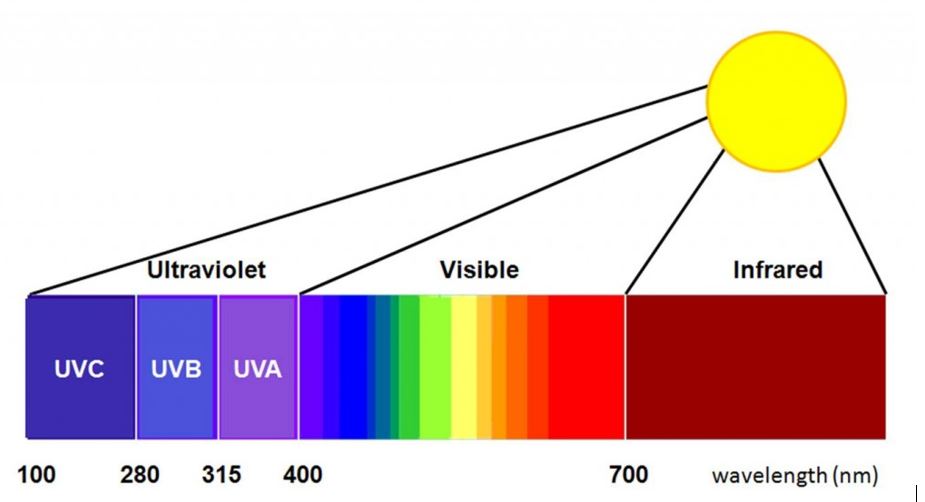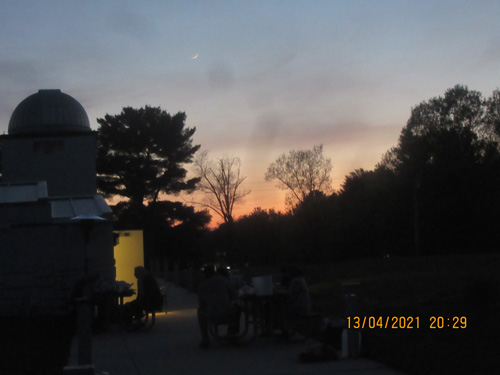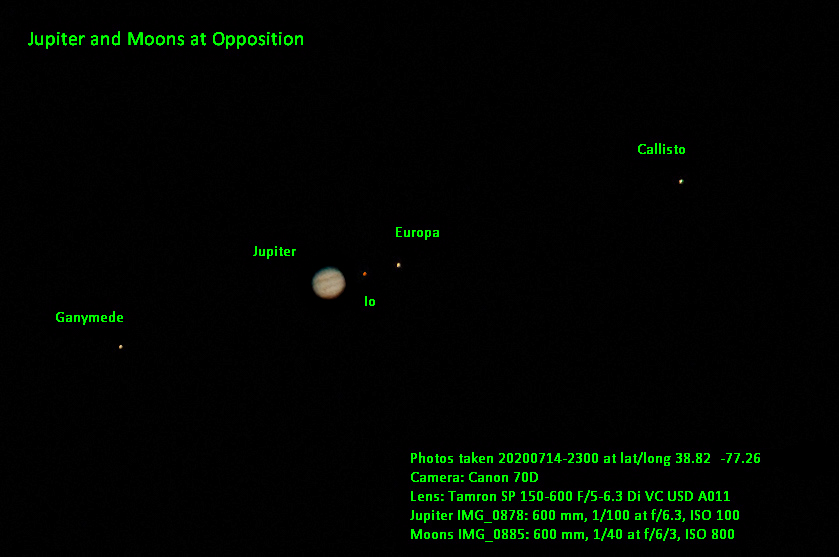- Details
- Category: Activities
On October 7th 2021 through coordination with the Fairfax County Park Authority, Analemma Society Volunteers hosted approximately a dozen enthusiastic home schoolers. Student were introduced to sundials and had the opportunity to make their own from a choice of paper cut-out dials. Even better, they took turns telling time from their own shadows using the sidewalk analemmatic sundial made by Scout Troop 1547 The sky was clear enough for Alan Figgatt to move a telescope with solar filter to show the disk of the sun. If you looked closely, you could see a sun spot. Then, the group headed down to the grounds of the Jamestown Sundial and volunteered to help clean up the area around the sundial that was open for viewing. Such enthusiasim...they had a weed pulling competition and did a terrific job cleaning out the weeds.
The group led by Afreen Nadeem sent a note of thank you: "We all wanted to thank you for setting up a fun and educational program for our homeschool group. The kids really enjoyed learning about the planets, sundials and seeing the sun spots through the solarscope. They enjoyed competing to weed the sundial area as well! Also for us moms, we learned alot and enjoyed the program as well. Thank you again for having us at the Turner Farm Observatory and for sharing all your knowledge and making this a memorable event for our kids."
And from the Analemma Society volunteers we appreciated having such enthusiastic and well behaved students visit the Observatory at Turner Farm. Below are a few photos of the HomeSchool students and their activities.

- Details
- Category: Activities
During springtime with the lengthening days, the amount of ultraviolet light your recieve increases. This is measured by the UV index that helpsyou know the sun burn potential and Vitamin D production of exposed human skin. Ultraviolet light is of shorter wavelengths than the blue and violet we can see. It is divided into three bands: UVA, UVB, and UVC. UVA and UVB that are responsible for tanning and Vitamin D production – and sunburn if you are exposed too long. Sunblock lotion absorbs UVB and UVA, helping prevent burns by extending the time you can safely stay out. UVC is normally blocked by our atmosphere and is the most energetic. Human sources of UVC light are used for disinfecting, but avoid direct exposure to it. The UV that affects us from the sun is UVA and UVB.

As the sun gets higher during the Spring and into Summer, its rays are more direct and concentrated in a more compact area, which you notice as warmer sunshine. A second factor has to do with the ozone “layer”, which is really more like froth on top of a wave than a layer. Ozone is a version of oxygen, O3 with three oxygen atoms, unlike the usual oxygen we are used to, O2 that we breathe. Ozone smells like bleach and can be formed in a lightning strike and produce the distinct odor that accompanies thunderstorms. Up in the stratosphere it forms when UV light strikes an oxygen atom. The ozone blocks UVC light and much of UVA and UVB until the sun moves very high in the sky. If you could see in UV, the sun would appear dim and hazy low in the sky, but as the sun goes high it appears much, much brighter in the ultraviolet..
During the winter at northerly latitudes, the sun is low in the sky and dim in the UV. It is virtually impossible to get a sunburn, no matter how long you are out. But as we approach the summer months the sun is higher in the sky during the midday hours and is now bright in the UV and you can suffer sunburn. On the one hand, exposure to sunshine provides Vitamin D, which some doctors recommend under carefully controlled conditions. However, too much exposure leads to sunburn and increased risk of skin cancer. For those with light skin the time it takes to get sunburned is shorter; in addition, some medications can make you more susceptible to sunburn, so you may want to consult your doctor about your medications.
Factors that determine the power of UV exposure include your latitude, your altitude, the clarity of the atmosphere and the reflectivity of the ground around you, along with the clothing and hat you are wearing. Because of high scattering of UV light, fully half of it comes from the open sky away from the sun. For this reason, one can get sunburned even in the shade if one is outdoors long enough. This is why using suntan lotion and/or clothing and hats to cover the skin if you are out for extended periods is important. We include a far from exhaustive list below of a few sources for further reading, and there are many others.
Some References for further reading
- Details
- Category: Activities
 It's sunset on the 13th of April, 2021. Members of a Reston mosque requested observing the crescent moon at Turner Farm Observatory Park for the beginning of Ramadan. A sunset visit was organized though the Fairfax County Park Authority and with observing assistance by volunteers from the Analemma Society. A total of 15 adults and children observed the crescent moon through hazy skys at sunset. Binoculars were at the ready for a better look. After sunset when skies darkened, all were treated to observations of the spring constellations. A Celestron NextStar telescope was positioned outside to provide views of the Moon, Mars, Messier 42 (the Orion Nebula) and a variety of other celestial wonders.
It's sunset on the 13th of April, 2021. Members of a Reston mosque requested observing the crescent moon at Turner Farm Observatory Park for the beginning of Ramadan. A sunset visit was organized though the Fairfax County Park Authority and with observing assistance by volunteers from the Analemma Society. A total of 15 adults and children observed the crescent moon through hazy skys at sunset. Binoculars were at the ready for a better look. After sunset when skies darkened, all were treated to observations of the spring constellations. A Celestron NextStar telescope was positioned outside to provide views of the Moon, Mars, Messier 42 (the Orion Nebula) and a variety of other celestial wonders.
In the photo at right can you fine the crescent moon? It's there if you look hard enough. The dark "smudges" in the sky are the remains of contrails created by planes from Dulles International Airport.
- Details
- Category: Activities
From October 2019 into February 2020 Betelgeuse underwent a dimming, losing two thirds of its luminosity. In a recent article by Dupree, et.al. in the 13 Aug 2020 issue of Astrophysical Journal (ApJ) analysis of Hubble Space Telescope spectroscopic ultraviolet observations of Betelgeuse showed that during Sep-Nov 2019 there was a brightening in the Mg-II and C-II emission lines. Doppler measurements suggested hot material moving outward.
The article abstract [ https://iopscience.iop.org/article/10.3847/1538-4357/aba516 ] concludes "It appears that this extraordinary outflow of material from the star, likely initiated by convective photospheric elements, was enhanced by the coincidence with the outward motions in this phase of the ~400 day pulsation cycle. These ultraviolet observations appear to provide the connecting link between the known large convective cells in the photosphere and the mass ejection event that cooled to form the dust cloud in the southern hemisphere imaged in 2019 December, and led to the exceptional optical dimming of Betelgeuse in 2020 February."

The above 4-panel graphic by E. Wheatley (STScI) illustrates in the first two panels the outflow burst suggested by the ionized magnesium and carbon observed Sep-Nov 2019. The third panel shows the outburst cooling and by coincidence in the direction of the earth. The final panel shows the material now cooled as a scattering dust cloud, significantly reducing the Earth's view of Betelgeuse, dimming its apparent luminosity for months.[ https://www.nasa.gov/feature/goddard/2020/hubble-finds-that-betelgeuses-mysterious-dimming-is-due-to-a-traumatic-outburst ]
- Details
- Category: Activities
 While some observers focused on Comet Neowise, George Bradshaw had his camera with telescopic lens focused on other solar phenomenon, taking an excellent photograph of Jupiter and its moons at opposition. George chose his timing carefully to have the four bright satellites of Jupiter strung out in a chain to both the left and right of the giant planet.
While some observers focused on Comet Neowise, George Bradshaw had his camera with telescopic lens focused on other solar phenomenon, taking an excellent photograph of Jupiter and its moons at opposition. George chose his timing carefully to have the four bright satellites of Jupiter strung out in a chain to both the left and right of the giant planet.
He writes, "I couldn't spot Neowise from south of Fairfax City -- too much haze and cloudiness on the horizon. But on Tuesday [14 July 2020] I captured Jupiter and its moons at opposition....Basic post-processing was performed in Lightroom and Photoshop; no image stacking was performed. The effect of "twinkling" was mitigated in Photoshop. Twinkling increased Jupiter's pixel diameter from 30 pixels to 40 pixels, so a 5-pixel band surrounding Jupiter was removed. Twinkling increased the moons' pixel diameters from less than one pixel to as much as 10 pixels; to ensure the moons would be visible on a web page, the moons' pixel diameters were reduced to about 4 pixels rather than 1 pixel." [For presentation here on the website, additional unsharp masking was applied. Webmaster]
Page 1 of 3

